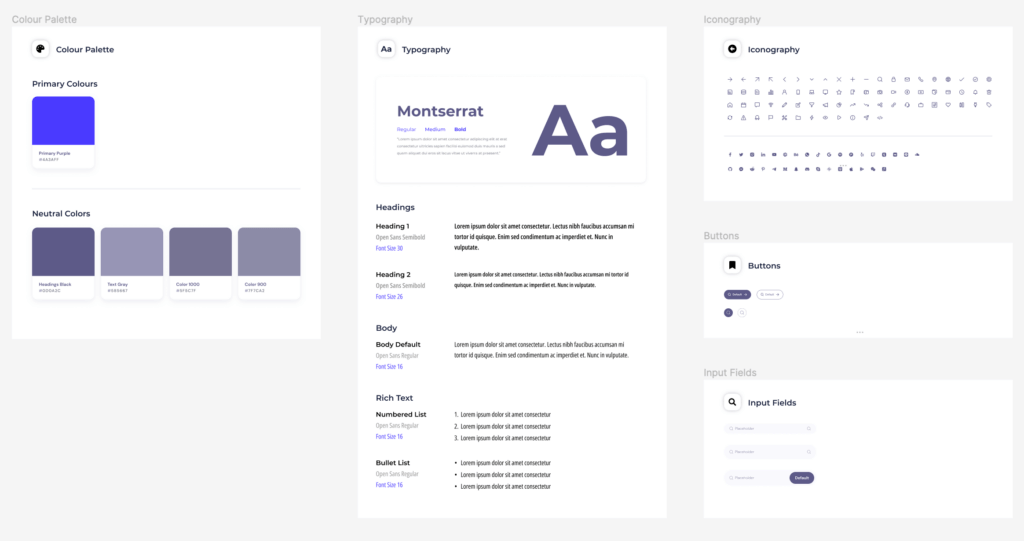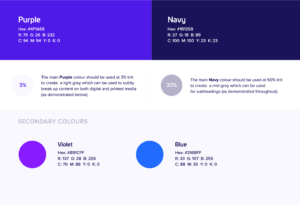What Are Brand Guidelines?
A Comprehensive Guide to Crafting and Implementing Brand Consistency.
In today’s fierce business landscape, consistent branding is paramount for success. This definitive guide unravels brand guidelines’ intricacies and central importance, serving as your steadfast compass in a world oversaturated with competing messages. These guidelines are the backbone of your brand’s public persona, providing clarity in a chaotic marketplace. Businesses powerfully communicate their values by championing a unified brand image nurturing brand recognition and loyalty.
1. Demystifying Brand Guidelines
Definition and Purpose of Brand Guidelines
At the heart of every memorable brand lies a robust set of brand guidelines. These comprehensive directives inform how the brand presents itself across myriad touchpoints. Beyond just rules or aesthetic dictates, they capture the ethos and essence of a brand, ensuring it remains undiluted and powerful. Whether you’re reaching out to stakeholders, partners, or the broader audience, these guidelines are your framework for a consistent and impactful narrative.

2. The Cornerstones of Brand Guidelines
Logo Usage and Variations
Your seemingly simple logo carries the weight of your brand’s identity. It’s more than an emblem—it’s the first handshake, the first impression, the unwavering flagpole. Brand guidelines dictate its sizing, positioning, and variations and underline the philosophy behind its design, ensuring it remains resonant and evocative.
Colour Palette and Typography

Every shade and font in your brand’s toolkit has been carefully chosen. Each hue reflects an emotion, a sentiment. The typography, in turn, mirrors the brand’s voice—be it authoritative, friendly, or innovative. Brand guidelines delve into the rationale behind these choices, ensuring your brand’s colours and type remain consistent across digital platforms, print materials, and offline events.
Visual Elements and Design Elements
Beyond logos and typography lies a world of design elements that craft your brand’s larger narrative. Every visual piece matters, from the images that capture moments to the icons that simplify complex ideas and the patterns that add layers of sophistication. Brand guidelines offer a deep dive into these design choices, ensuring each visual cue aligns perfectly with your brand’s essence.
Voice and Tone
A brand’s heart lies in its voice. Whether it whispers or shouts, reflects introspection or exudes exuberance, this voice is the essence of brand communication. Brand guidelines act as the North Star, ensuring every message, campaign, and statement embodies this unique voice, fostering trust and connection with the audience.
3. Applying Brand Identity with Precision
Print and Digital Collateral
From the texture of your business cards to the dynamic animations on your website, every touchpoint is an opportunity to reiterate your brand’s story. Brand guidelines detail the delicate nuances of translating your brand essence across mediums, ensuring a seamless, memorable experience at every interaction.
Advertising and Marketing Campaigns
Every marketing campaign, regardless of scale, is a chapter in your brand’s evolving tale. Brand guidelines equip you with the tools and directives to tell this story compellingly, ensuring a cohesive brand experience, whether it’s a billboard, a social media post, or a television advert.
Brand Partnerships and Co-Branding
Navigating the waters of partnerships requires a delicate balance. While collaboration brings innovation, ensuring your brand’s voice is heard is essential. Brand guidelines elucidate the fine art of co-branding, offering strategies to seamlessly integrate multiple brand identities, ensuring synergy without losing individuality.

4. Ensuring Adherence to Brand Guidelines
Training and Onboarding
The true guardians of a brand’s identity are its internal teams. Arming them with in-depth knowledge and insights about the brand guidelines ensures that every outward communication remains true to the brand’s core. Brand guidelines extend beyond mere directives—they offer context, rationale, and the stories that birthed these decisions, fostering a deeper connection and understanding.
Monitoring and Quality Control
Consistency is the pillar of brand trust. Through a vigilant monitoring and quality assurance system, guidelines provide a roadmap to assess and refine brand materials. Regular audits, feedback loops, and case studies ensure the brand’s essence remains undiluted.
Evolving and Updating Brand Guidelines
In the ever-evolving realm of business, brands aren’t static. They grow, adapt, and redefine themselves. Recognising this fluidity, guidelines offer insights into the cyclical process of evaluation and refinement, ensuring the brand remains relevant while staying true to its roots.
Frequently Asked Questions
What are the essential elements to include in brand guidelines?
When crafting brand guidelines, think of it as a blueprint for your brand’s identity. Essential elements include:
Logo Usage: It’s not just about what your logo looks like but also how and where it’s placed.
Colour Palette: A cohesive set of colours that represent your brand’s personality and messaging.
Typography: Specific fonts that align with your brand’s voice and image.
Visual Elements: This encompasses imagery, illustrations, icons, and other graphical assets.
Voice and Tone: Instructions on the brand’s communication style, ensuring consistent messaging across platforms.
How can brand guidelines benefit businesses?
For businesses, brand guidelines are a catalyst for growth. They provide a consistent framework, ensuring every interaction resonates with the audience and leaves a lasting impression. More than that, brand guidelines streamline decision-making, instil professionalism, and help businesses stand out in a crowded marketplace.
Can brand guidelines accommodate different marketing channels and platforms?
Absolutely. Brand guidelines are versatile and adaptive. They aren’t rigid rules but rather a guiding light. Whether it’s a social media post, a billboard, or an email campaign, these guidelines ensure your brand is presented consistently and effectively. They can be tweaked and adjusted to suit different platforms while preserving the core brand identity.
Are there any tools or software available to help create brand guidelines?
Certainly, there’s a whole suite of tools out there to help craft comprehensive brand guidelines. Platforms like Adobe Spark, Canva’s Brand Kit, and Frontify can assist in creating visually appealing and detailed guidelines. These tools provide templates and frameworks, simplifying the process while ensuring professional outcomes.
When crafting brand guidelines, think of it as a blueprint for your brand’s identity. Essential elements include:
Logo Usage: It’s not just about what your logo looks like but also how and where it’s placed.
Colour Palette: A cohesive set of colours that represent your brand’s personality and messaging.
Typography: Specific fonts that align with your brand’s voice and image.
Visual Elements: This encompasses imagery, illustrations, icons, and other graphical assets.
Voice and Tone: Instructions on the brand’s communication style, ensuring consistent messaging across platforms.
For businesses, brand guidelines are a catalyst for growth. They provide a consistent framework, ensuring every interaction resonates with the audience and leaves a lasting impression. More than that, brand guidelines streamline decision-making, instil professionalism, and help businesses stand out in a crowded marketplace.
Absolutely. Brand guidelines are versatile and adaptive. They aren’t rigid rules but rather a guiding light. Whether it’s a social media post, a billboard, or an email campaign, these guidelines ensure your brand is presented consistently and effectively. They can be tweaked and adjusted to suit different platforms while preserving the core brand identity.
Certainly, there’s a whole suite of tools out there to help craft comprehensive brand guidelines. Platforms like Adobe Spark, Canva’s Brand Kit, and Frontify can assist in creating visually appealing and detailed guidelines. These tools provide templates and frameworks, simplifying the process while ensuring professional outcomes.






